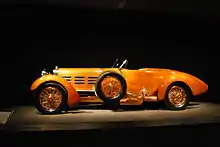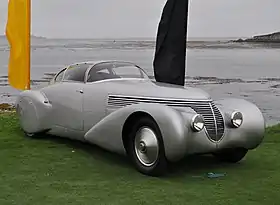Hispano-Suiza H6
The Hispano-Suiza H6 is a luxury car that was produced by Hispano-Suiza, mostly in France. Introduced at the 1919 Paris Motor Show,[2] the H6 was produced until 1933. Roughly 2,350 H6, H6B, and H6C cars were produced in total.
| Hispano-Suiza H6 | |
|---|---|
 Hispano-Suiza 1924 H6B Million-Guiet Dual-Cowl Phaeton | |
| Overview | |
| Manufacturer | Hispano-Suiza |
| Production | 1919–1933 |
| Assembly | France: Paris (Bois-Colombes factory)[1] |
| Designer | Marc Birkigt |
| Body and chassis | |
| Class | Luxury car |
| Layout | FMR layout |
| Powertrain | |
| Engine | 6597 cc straight-6 7983 cc straight-6 |
| Transmission | 3-speed manual |
| Chronology | |
| Successor | Hispano-Suiza J12 |
Specifications
The H6 engine featured a straight-six engine inspired by designer Marc Birkigt's work on aircraft engines.[3] It was an all-aluminium engine displacing 6,597 cubic centimetres (403 cu in).[4] Apart from the new overhead camshaft, it was essentially half of Birkigt's aviation V12 design.[3] The seven-bearing[4] crankshaft was milled from a 600 lb (272 kg) steel billet to become a sturdy 35 lb (16 kg) unit,[2] while the block used screwed-in steel liners,[4] and the water passages were enamelled to prevent corrosion.[5]
One of the most notable features of the H6 was its brakes. They were light-alloy drums on all four wheels[5] with power-assist[2][3] the first in the industry, driven with a special shaft from the transmission. When the car was decelerating, its own momentum drove the brake servo to provide additional power.[2] This technology was later licensed to other manufacturers, including arch-rival Rolls-Royce.[6]
The 1922 H6B was slightly more powerful. An 8.0-litre (488 cu in) (110 by 140 mm (4.3 by 5.5 in)) engine was used in 1924's H6C.[2]
The H6 series was replaced in 1933 by the J12, which initially used a 9.5-litre (580 cu in) V12 pushrod engine.
Special versions
A series of five racing H6Bs with short wheelbases and slightly enlarged engines was built in 1922.[2] These were referred to as "Boulogne", to celebrate the H6's triple victory at the sports car race at Boulogne by pilots Dubonnet, Garnier & Boyriven in 1923 (Journal des debats, July 27, 1923).[2][6] Woolf Barnato piloted a Boulogne to eight international records, including a 92 mph (148 km/h) average over 300 mi (480 km), at Brooklands in 1924.[5]
.JPG.webp)
André Dubonnet entered an H6C Boulogne in the 1924 Targa Florio.[7] Powered by a 7,982 cc (487.1 cu in) straight 6 (estimated to produce 195 hp (145 kW)),[8] Dubonnet demanded a maximum body weight of 100 lb (45 kg),[5] and the aircraft maker Nieuport- Astra complied with tulipwood strips[7] (later determined to have been mahogany), fastened to an aluminium frame with thousands of tiny rivets.[7] Dubonnet finished the gruelling event without a body failure, and drove home to Naples afterward.[8] This vehicle is currently housed at the Blackhawk Museum near Danville, California.
A later series of short-wheelbase H6Cs was built, eventually being referred to as "Monzas".[2]

A six-wheeled H6A was ordered by the King of Greece, but after his abdication was purchased by the motion picture director D. W. Griffith. It is now at the Forney Museum in Denver.[9]

Specifications: 1924 H6C Dubonnet Boulogne Targa Florio speedster

- Length: 5,537 mm (218.0 in)
- Width: 1,791 mm (70.5 in)
- Height
- cowl: 1,245 mm (49.0 in)
- windshield: 1,524 mm (60.0 in)
- Wheelbase: 3,378 mm (133.0 in)
- Wheels: 508 mm (20.0 in) center-locking
- Weight: 1,583 kg (3,490 lb)
- Transmission: three-speed manual
- Suspension:
- Front: beam
- Rear: live axle, semi-elliptic leaf spring
- Engine: Hispano-Suiza straight 6
- Bore: 110 mm (4.3 in)
- Stroke: 140 mm (5.5 in)
- Displacement: 7,982 cc (487 cu in)
- Maximum power: 195 hp (145 kW) at 3000 rpm (estimated)[8]
Škoda
Some early H6s were built at Hispano-Suiza's industrial complex at La Sagrera, Barcelona, but most H6s were built at Hispano-Suiza's French division in the Parisian suburb of Bois-Colombes. Some 100 H6s were built under license by Škoda in Czechoslovakia from 1926 to 1929. To cope with the poor fuels available, the compression ratio had been limited to 4.5:1 and engine power to 100 hp (75 kW) at 1800rpm.[10][11]

H6B Dubonnet Xenia
In 1938, Hispano-Suiza built a one-off H6B for André Dubonnet, in which he installed the engine from the H6C, his own custom suspension system, and custom bodywork by coachbuilder Saoutchik. This H6B served as his own personal car, as well as a showcase of his automotive technologies and aerodynamical innovations. The H6B Dubonnet Xenia is currently owned by Peter W. Mullin and is on display at the Mullin Automotive Museum in Oxnard, California.
In popular culture
In Miss Fisher's Murder Mysteries, Australian detective Phryne Fisher drives a red 1923 Hispano-Suiza H6, which makes frequent appearances in the television series.[12]
The Hispano-Suiza is the favoured automobile of the Duke de Richleau, hero of several novels by Dennis Wheatley, including the best-selling The Devil Rides Out (1934).
The character “Bundle” in Agatha Christie’s 1929 novel The Seven Dials Mystery drives a Hispano-Suiza.
References
| Wikimedia Commons has media related to Hispano-Suiza H6. |
Citations
- Bonhams : 1930 Hispano-Suiza H6B Coupe ChauffeurChassis no. 12202Engine no. 302163: Bonhams : 1930 Hispano-Suiza H6B Coupe ChauffeurChassis no. 12202Engine no. 302163, accessdate: 9. July 2019
- Ultimatecarpage.com – Hispano Suiza H6C Monza
- Conceptcarz.com – 1922 Hispano Suiza H6B
- Browne, T.C. p.118.
- Browne, T.C. p.119.
- Autos.ca: Motoring Memories – Hispano-Suiza
- Browne, T. C., p.119-20.
- Browne, T. C., p.120.
- Forney Museum of Transportation – 1923 Hispano Suiza Victoria Town Car
- "Nachtschicht im Schloss: A report on a concours d'elegance at Schloss Bensberg". Auto Motor u. Sport. Heft 25 2010: Seite 12. 18 November 2010.
- "Škoda – Hispano Suiza 25/100 KS (1926–1929): Poprvé s okřídleným šípem" (in Czech). Veteran Auto. 10 May 2011. Archived from the original on 22 May 2013. Retrieved 11 May 2013.
- "1923 Hispano-Suiza H6 in "Miss Fisher's Murder Mysteries, 2012–2013"". IMCDB. Retrieved 6 November 2016.
Sources
- Browne, T. C. (April 1984). "Retrospect: 1924 Hispano-Suiza H6c Speedster". Motor Trend. Petersen Publishing. 36 (4): 118–120. ISSN 0027-2094. OCLC 317295525.
- Melissen, Wouter (2004-12-13). "Ultimatecarpage.com - Hispano Suiza H6C Monza". Ultimatecarpage.com. Wouter Melissen. Retrieved 2009-01-11. External link in
|work=(help) - Vance, Bill (2001-03-12). "Motoring Memories: Hispano-Suiza". Autos.ca. Orleans, Ontario, Canada: Canadian Driver Communications. Retrieved 2011-10-17. External link in
|work=(help) - "Conceptcarz.com - 1922 Hispano Suiza H6B". Conceptcarz.com. Daniel Vaughan. Retrieved 2009-01-11. External link in
|work=(help) - "Forney Museum of Transportation - 1923 Hispano Suiza Victoria Town Car". Forney Museum of Transportation. Denver, Colorado. Retrieved 2011-10-17. External link in
|work=(help)